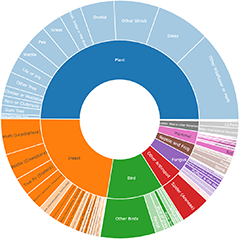Clubs/stalks on soil
The genera Clavaria, Clavulina, Clavulinopsis and Ramariopsis contain species with fleshy fruitbodies up to 10 centimetres long and half a centimetre thick. Common colours are white, yellow, orange and red. The fruitbodies may grow sparsely, gregariously (but clearly as distinct fruitbodies) or in a dense cluster (and it would be easy to mistake such a cluster of separate fruitbodies for a single, branched fruitbody – until you look closely). As a group these fungi are common and easily seen, given the sizes and colours. Some species are recognizable visually but others demand a microscopic study to be sure of an identification.
Geoglossum fruitbodies (known as Earth tongues) are fleshy, black, with a broader apex and may grow to several centimetres tall.
Warning
If the fruitbody is black and stiff look for Xylaria in the On wood sub-group (https://canberra.naturemapr.org/Community/Categories/Guide/1730). Species of Xylaria are mostly found obviously on wood but sometimes you find them growing from buried wood.
Announcements
There are currently no announcements.
Discussion
Not unlike Clavaria redoleoalii at first glance - note difference in stem
Clavaria fragilis group
Top contributors
- Teresa 16
- trevorpreston 9
- TimL 7
- Bushrevival 6
- LisaH 4
- BrianH 3
- Csteele4 3
- RobG1 3
- mahargiani 2
- MattFox 2
Top moderators
- Teresa 25
- Heino1 21
- Heinol 10
- MichaelMulvaney 9
- Pam 4
- trevorpreston 3
- Csteele4 3
- robndane 1
- AaronClausen 1
- Heino 1



